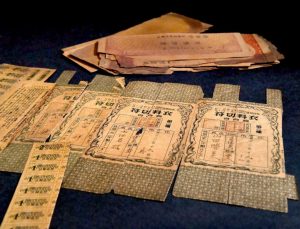Silent Witness: Ration tickets for clothing
Feb. 21, 2022
Life under government control etched into tickets
by Miho Kuwajima, Staff Writer
The collection of “clothing ration tickets” remains mostly unused. The late Katsumi Yamada, 40 years old at the time, who operated an auto parts store in Hiroshima’s Hatchobori area (now part of the city’s Naka Ward), had kept hold of the ration tickets. Despite being in a completely incinerated area about 800 meters from the hypocenter, the tickets’ location in a safe deposit box resulted in their miraculous escape from the fires that arose after the atomic bombing.
Amid increasingly severe commodity shortages during World War II, Japan’s national government distributed clothing ration tickets to every household in an attempt to manage the supply of goods. Under the system, people would exchange a specified number of ration tickets for shirts, towels, or other items. However, as the war intensified, a shortage persisted of goods for which the tickets could be exchanged.
In April 1985, the 40th year after the atomic bombing, Mr. Yamada donated the clothing ration tickets to the Hiroshima Peace Memorial Museum along with his post-office savings account book and insurance policies that he had been keeping in his safe deposit box. Some of the documents have traces of what appear to be burns from the fires caused by the A-bombing’s thermal rays. Due to the severity of their deterioration, the tickets and other documents usually remain archived in a storehouse in the museum basement.
Mr. Yamada is thought to have lost his mother, older brother, and older sister in the atomic bombing, but few records exist of an interview of him by museum staff at the time he donated the items. The names of his wife Kimie and his sons are inscribed on the clothing ration tickets, quiet evidence that the family once indeed lived in Hiroshima’s Hatchobori area.
(Originally published on February 21, 2022)








